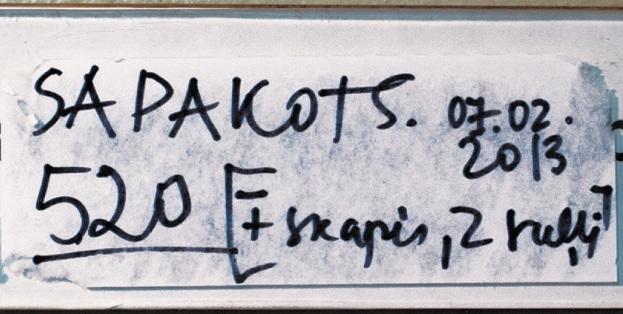 (C) Māra Brašmane
(C) Māra BrašmaneSolo exhibition "A Time of Change" by Māra Brašmane will be opened on 9th May at the Arsenāls Exhibition Hall / Creative StudioThe Latvian National Museum of Art 2nd floor, 1 Torņa Street. The exhibition is a part of Riga Photomonth 2014. and it will be on view until 1. June
When Māra Brašmane (b. 1942) first got her hands on her father’s wide-lens Voigtländer camera, she began to look for ways to use an image to freeze a moment of time. Just like one of the pioneers of French documental photography, Eugène Atget (1857–1927), who captured the unpretentious charm of the slowly disappearing narrow streets of old Paris and the residents thereof, Māra Brašmane has encapsulated things, events and moods in her photo series that have only existed in the past.
The photographer has devoted most of her professional life to museums, and stood witness to its visual and institutional change. In 1973, Māra Brašmane joined the staff at the Rundale Palace Museum as a young specialist. This was a time when the first restoration was taking place and there was a need for photographs of the objects that were to be restored. Rundale, along with trips to Latvian palaces and estates, became what Māra describes as her “school of art.” She learned more about her job and gained in-depth knowledge in the history of art. After 11 years, she returned to Riga, the city of her youth, and was hired by what today is the Latvian National Museum of Art (LNMA). Māra Brašmane worked there as a staff photographer for 20 years (1984–2004), witnessing the transportation of exhibits, the establishment of an exposition of Soviet Latvian Art, and then the transfer of some of the collection to new facilities at the Arsenāls Exhibition Hall, renovation of the White Hall, and the opening of the Hege Hall.
The topic of museums became a personal and creative challenge for Māra Brašmane in 2005, when the exhibition “Museum People” was organised at the Small Hall of the museum. Early in 2013, she examined reconstruction plans and visualisation of the museum’s main building at 10a K. Valdemāra Street, visited the concluding exhibition, and carefully toured the museum’s facilities. This created the idea of a new photo project in which the central focus would be on the building itself, as opposed to people and artworks.
The various black-and-white and colour photographs that are part of the exhibition “Time of Change” are devoted to the main building of the LNMA. After reconstruction, it will have exhibition halls in the attic and the basement, lifts and restored spaces, providing it with a completely new identity. Māra Brašmane took the opportunity to record the building when most of the art had been removed from it, as had its archives and office equipment. Walls had been denuded of their plaster, and doors were open to rooms that had been unavailable for a long time to the visitors of the museum and, in some cases, the museum’s employees, as well. Māra spent an average of 4 to 6 hours at the museum for a 12-day period. Her last visit was on 26 April 2013, when the museum had been completely emptied, and the keys had been turned over to the workers dealing with reconstruction.
Māra Brašmane has produced several thematic series of images such as “Museum Attic,” “Packaging Room,” “Restoration Workshop” and “Heating System.” These allow viewers to examine all of the rooms of the museum in sequence. The artist has captured layers of paint, ornaments that were once hidden behind the white textile wallpapers, as well as dry rot from the walls of the museum which staff breathed for many decades. The objects and rooms in the images speak about the physical and intangible impressions of time – ones that organically turn into paintings of pure colours, lines, and contrasts between light and dark. Bare rooms, abandoned by both artworks and people, are revealed to the view. For a moment the museum's function has been taken away, and a silent expectation hesitates before a new beginning.